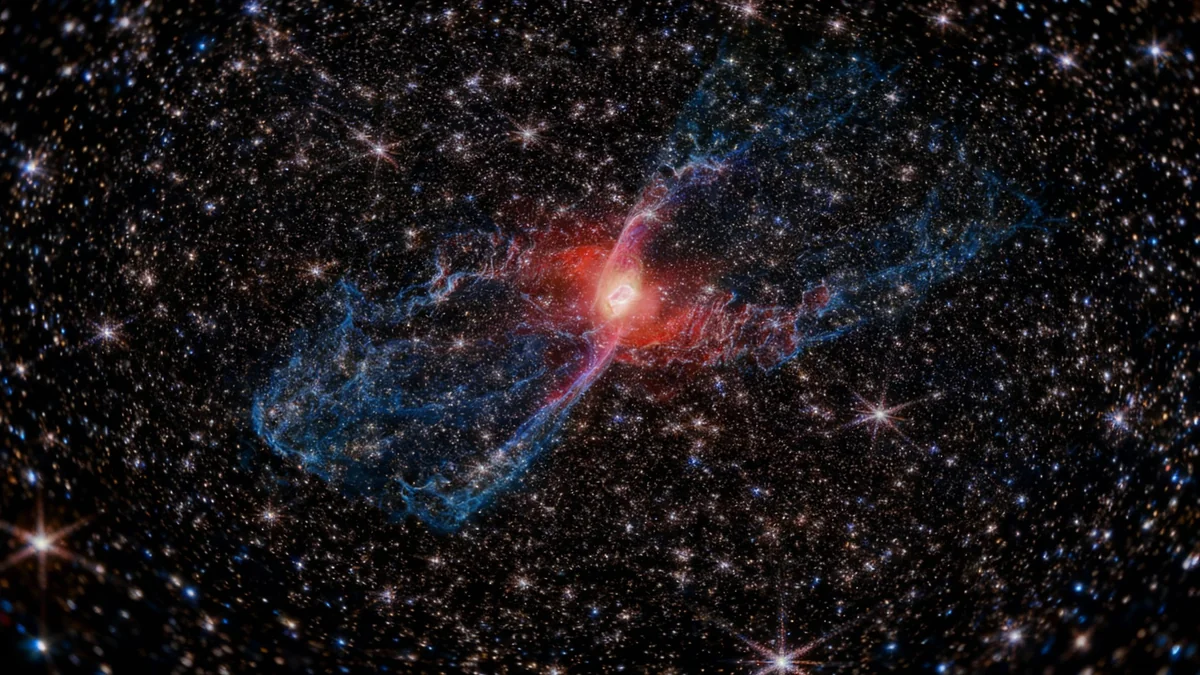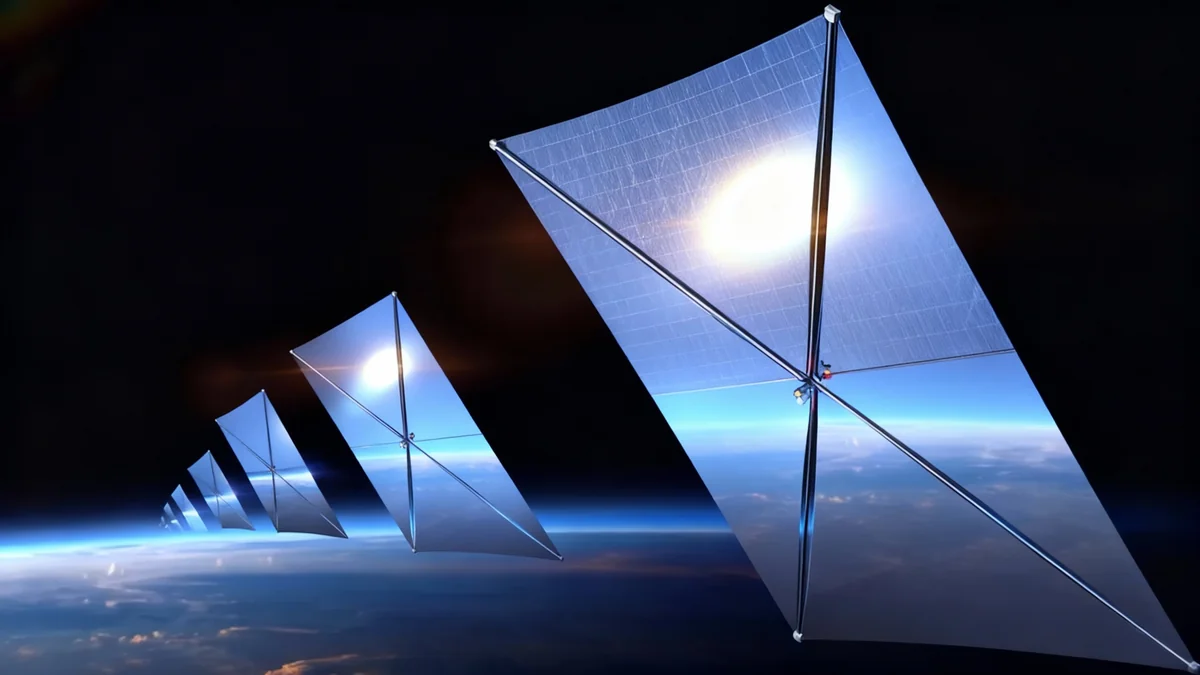The James Webb Space Telescope has captured an exceptionally detailed image of the Red Spider Nebula, offering scientists an unprecedented look at a dying star. The new data not only reveals the intricate structures of the nebula but also provides a preview of what our own solar system might experience in billions of years.
Released in time for Halloween, the image showcases the chaotic final stages of a star similar to our sun. The star is shedding its outer layers, creating a vast and complex structure of gas and dust that glows intensely from the radiation of its exposed, superheated core.
Key Takeaways
- The James Webb Space Telescope (JWST) has captured a new, highly detailed image of the Red Spider Nebula (NGC 6537).
- The image reveals never-before-seen features, including intricate filaments of molecular hydrogen described as "hairy."
- This nebula is the result of a dying star ejecting its outer layers, a process our own sun will undergo in about 5 billion years.
- The study of this nebula helps scientists understand the final evolutionary stages of sun-like stars and the future of our solar system.
A New Look at a Cosmic Arachnid
The latest observation from the JWST's Near-Infrared Camera (NIRCam) has pierced through cosmic dust to deliver a stunningly clear view of the Red Spider Nebula. The image highlights the violent and beautiful process of a star's death, where vast clouds of gas and dust are expelled into space.
At the center of this cosmic web is a white dwarf, the incredibly hot and dense remnant of a star that has exhausted its primary nuclear fuel. The intense ultraviolet radiation pouring from this stellar core is what illuminates the surrounding gas, causing it to glow in intricate patterns.
The nebula's distinctive two-lobed structure, resembling the body and legs of a spider, is formed by powerful stellar winds and radiation pushing the ejected material outwards. These lobes stretch across space, creating massive bubbles of superheated gas that have been expanding for thousands of years.
What is a Planetary Nebula?
Despite the name, a planetary nebula has nothing to do with planets. The term was coined by early astronomers who thought these glowing, rounded objects resembled planets through their less powerful telescopes. In reality, they are shells of glowing gas and dust ejected from stars of a certain mass as they reach the end of their lives. Our own sun is expected to form a planetary nebula in the distant future.
The Mystery of the 'Hairy' Legs
This new JWST image has brought a peculiar feature into sharp focus. Scientists are intrigued by what they describe as "hairy" filaments that appear to cover the spider-like legs of the nebula. These structures are shining with the light of molecular hydrogen.
"The legs are hairy and shine with molecular hydrogen emission, which have escaped from the torus," said Mikako Matsuura, an astrophysicist at Cardiff University and a co-investigator on the project. "It is still unclear why the outflows appear 'hairy'."
Researchers are exploring several possibilities to explain this unusual texture. One leading theory suggests that the outflow of material from the primary star was not a smooth, continuous process. Instead, it may have occurred in pulses or bursts.
This irregular ejection could be influenced by a hidden companion star. Scientists believe the central star in the Red Spider Nebula is part of a binary system. The gravitational pull of this unseen partner could disrupt the flow of mass, affecting the timing and shape of the material being cast off into space.
A Star's Final Act
The creation of the Red Spider Nebula is a dramatic final chapter in a star's life. For most of its existence, a star like our sun generates energy by fusing hydrogen into helium in its core. When the hydrogen fuel runs out, the star's life takes a dramatic turn.
It begins to fuse helium into heavier elements, a process that releases a tremendous amount of energy. This causes the star to expand dramatically, swelling into a red giant hundreds or even thousands of times its original size. The star at the center of NGC 6537 has already gone through this phase.
After the red giant phase, the star sheds its outer layers of gas and dust. This material forms the expanding cloud that we see as the planetary nebula. Left behind is the small, hot core—a white dwarf—which will gradually cool and fade over billions of years.
The Future of Our Solar System
- 5 Billion Years: The sun will exhaust its hydrogen fuel and begin to swell into a red giant.
- Expansion Phase: As a red giant, the sun will likely engulf Mercury, Venus, and possibly Earth and Mars.
- Final Stage: After shedding its outer layers to form a planetary nebula, the sun's core will become a white dwarf.
A Window into Earth's Distant Future
While fascinating in its own right, the study of the Red Spider Nebula holds profound implications for understanding our own cosmic neighborhood. In approximately 5 billion years, our sun will follow a similar path.
As it transforms into a red giant, its expanding outer layers will consume the inner planets. Mercury and Venus are certain to be destroyed, while the fate of Earth and Mars hangs in the balance. Even if our planet survives being swallowed, the intense heat would render it completely uninhabitable.
After this destructive phase, the sun will cast off its own atmosphere, creating a new planetary nebula in our solar system. The remaining white dwarf at its center will illuminate this newly formed structure. By studying objects like the Red Spider Nebula today, astronomers can model and predict the final, spectacular stages of our own star's life.
Images like this one from the James Webb Space Telescope are more than just beautiful cosmic portraits. They are scientific tools that allow us to witness the processes that shape the universe and offer a direct, if unsettling, look at the ultimate destiny of our own sun.





